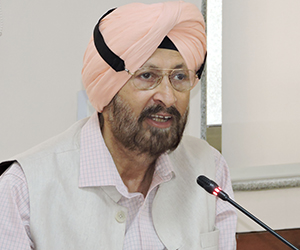Contrary to most of the commentary that has appeared in the Indian media, the Obama-Manmohan Singh meeting at the White House on September 26, 2013 was unexpectedly successful in setting the Indo-US strategic partnership on the path to a higher trajectory in the long term. The joint statement issued after the meeting and the Joint Declaration on Defence Cooperation endorsed by the two leaders have the potential to perceptibly shape the future contours of the relationship to mutual benefit.
The most notable achievement of the summit was in the field of defence cooperation and, more particularly, defence trade. President Barack Obama and Prime Minister Manmohan Singh called for “expanding security cooperation between the United States and India to address 21st century challenges.” In an unexpected move, the two leaders endorsed a Joint Declaration on Defence Cooperation “as a means of enhancing their partnership in defence technology transfer, joint research, co-development and co-production.” They decided to significantly enhance cooperation in combatting terrorism. President Obama appreciated India’s decision to participate in the Rim of the Pacific (RIMPAC) naval exercise to be hosted by US Pacific Command in 2014.
For several decades, India’s procurement of weapons platforms and other equipment as part of its plans for defence modernisation has remained mired in disadvantageous buyer-seller, patron-client relationships like that with the erstwhile Soviet Union and now Russia. While India has been manufacturing Russian fighter aircraft and tanks under license for many years, the Russians never actually transferred weapons technology to India, though this could change with the Fifth Generation Fighter project and other similar projects. There is now realisation in India that future defence acquisitions must simultaneously lead to a transformative change in the country’s defence technology base and manufacturing prowess.
The country has now diversified its acquisition sources beyond Russia to Western countries and Israel. From the US, India has purchased weapons platforms and other items of defence equipment worth USD 10 billion over the last five years. Major procurements have included the troop carrier ship INS Jalashva (USS Trenton), six C-130J Super Hercules aircraft for India’s Special Forces, ten C-17 Globemaster heavy lift transport aircraft, 12 Boeing P-8I Poseidon long-range maritime reconnaissance aircraft and 12 AN-TPQ37 Weapon Locating Radars. Another six C-130J and seven C-17 aircraft are expected to be purchased over the next few years. Also in the acquisition pipeline are M-777 light artillery howitzers, Apache attack helicopters and Chinook medium lift helicopters.
However, none of the recent deals with the US have included transfer-of-technology (ToT) clauses. It is imperative that whatever India procures now must be procured with a ToT clause being built into the contract even if it means having to pay a higher price. The aim is to make India a design, development, manufacturing and export hub for defence equipment in two to three decades.
The Joint Declaration on Defence Cooperation agreed during the Indian PM’s visit in September 2013 is a major step forward towards greater cooperation in the defence trade relationship. The US and India have agreed to treat each other “at the same level as their closest partners” in respect of defence technology transfer, trade, research and joint development and joint production, including the most advanced and sophisticated technologies. The two sides agreed to “identify specific opportunities for cooperative and collaborative projects in advanced defence technologies and systems.”
This is indeed a landmark agreement that has codified previously expressed intentions. The major implication of this agreement is that the US will treat India just like the United Kingdom, which is an alliance partner, without India having to enter into a military alliance with the US. Also, presumably, India will not have to sign the CISMOA, BECA and LSA agreements that have been major stumbling blocks in the past and about which it has differences of perception with the US. India is hungry for cutting edge state-of-the-art defence technology and this agreement will help to a large extent to fulfil India’s hi-tech requirement. On its part, the US will secure lucrative defence contracts for its leading defence companies. This will give a fillip to the flagging economy and help to create jobs.
During his visit to India shortly before the Washington summit in September 2013, Deputy Secretary of Defence Ashton Carter is reported to have offered India a “Defence Trade and Technology Initiative” under which the US will share sensitive cutting edge defence technology with India and to permit US companies to enter into joint production and co-development ventures with India. Subsequently, it was reported that Deputy Secretary Carter had offered a list of ten key technologies to India. "These include a maritime helo, a naval gun, a surface-to-air missile system, and a scatterable anti-tank system,” Carter said. "We changed our mind-set around technology transfer to India in the Department of Defence from a culture of presumptive no to one of presumptive yes," he said.
The Javelin anti-tank guided missile (ATGM) is also a key candidate for joint production though so far the US has been hesitant to offer its seeker technology. India is also looking for high-end counter-IED technologies. In future, the two countries will conduct joint research and development for new weapons systems and the US may offer even nuclear power packs for submarines and aircraft carriers and fighter aircraft engines. Cooperation of such a high order will raise India’s technology base by an order of magnitude and help the country to move several notches higher in its quest for self-reliance in defence production.
According to Shiv Shankar Menon, India’s National Security Advisor, the two countries now have a “Full spectrum relationship… the relationship has all the attributes of a strong and comprehensive strategic partnership.” In the years ahead, India and the US are bound to build further on the beneficial achievements of the last decade. Naturally, there will occasionally be some bumps on the highway, but there is reason to believe that the institutional mechanisms that are already in place will succeed in overcoming the obstacles that come up.
Published Date: 18th October 2013, Image Source: http://timesofindia.indiatimes.com










Post new comment